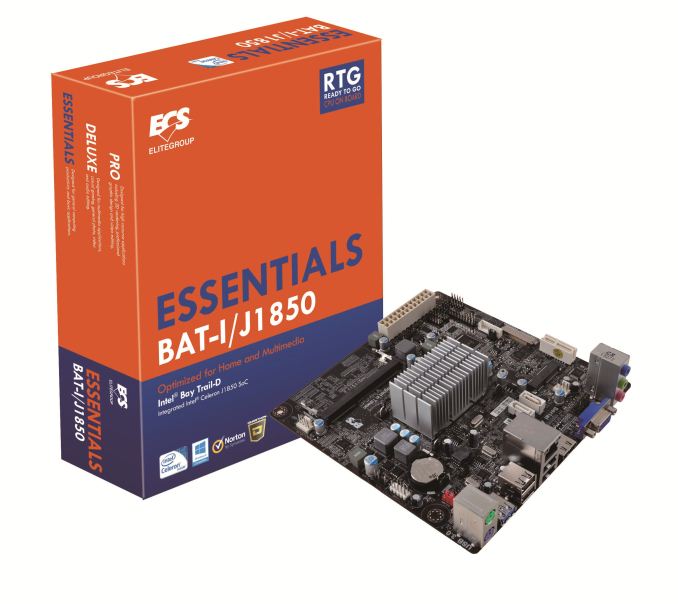ECS Reveals Bay Trail-D Mini-ITX Line
by Ian Cutress on October 23, 2013 3:32 AM EST- Posted in
- Motherboards
- Mini ITX
- ECS
- Silvermont
- SoCs
- Bay Trail
3D BOX&MB_678x452.JPG)
With Intel's Bay Trail platform and Silvermont Atom cores in the news for tablets, we have spotted their use in mini-ITX platforms as far pack as Computex 2013 where model numbers of Celeron Silvermont systems were on display. While these platforms are aimed at embedded systems on the desktop side, there is a small inkling that SFF PCs and AIOs will benefit too. To this extent, ECS (Elitegroup Computer Systems) has revealed their initial mini-ITX Bay Trail-D lineup, codename 'BAT-I'.
The difference in designation will be the CPU name in the product: the three products will offer a Pentium J2850 (quad core, 2.4 GHz), a Celeron J1850 (quad core, 2 GHz) and a Celeron J1750 (dual core, 2.4 GHz). All systems are paired with Intel HD Graphics (Ivy Bridge based), one mPCIe 2.0 x1 slot, one USB 3.0 port and two SATA 3 Gbps, as well as two COM ports.
Aside from the passive heatsinks (the SoCs have a Max TDP of 10W) these systems will need DDR3L-1333 SODIMM memory, and the HDMI/VGA will support 1080p and BluRay playback. Due to the price point and feature set, they fall under ECS' 'Essentials' range like the KBN-I, whereas the Deluxe/Pro ranges are reserved for more prominent builds.
I have requested release dates and pricing, update to follow.



3D BOX_thumb.JPG)
3D BOX&MB_thumb.JPG)








41 Comments
View All Comments
ShieTar - Wednesday, October 23, 2013 - link
Is it just me, or are many Mini-ITX boards a bit heavy on the legacy connectors?2xCOM, two PS/2-Connectors, VGA on this one.
And on the other hand, no DP nor DVI, no support for 5.1-Audio or digital Audio, only one USB3.
Is there any market research behind this, that there is a significant number of people trying to replace legacy systems with SFF options, while keeping their old periphery?
Reflex - Wednesday, October 23, 2013 - link
As pointed out in the article, these are aimed at the embedded market. To that market, which often has to interface with legacy equipment that is kept in operation for decades at a time, legacy connectors are a must have.Flunk - Wednesday, October 23, 2013 - link
Don't forget microcontrollers, COM ports are a lot easier and cheaper than having to deal with USB.fteoath64 - Thursday, October 24, 2013 - link
Examples are cash register in your local supermarket running Dos based programs churning away and the standard ATM machine are also DOS based custom devices doing specific functions.SirMaster - Wednesday, October 23, 2013 - link
Well it has HDMI so that's your up to 8 channel digital audio. IMO S/PDIF is legacy since the advent of BluRay and its lossless audio.Guspaz - Wednesday, October 23, 2013 - link
S/PDIF can still come in really handy, though, since it makes it easier to run audio and video to separate devices without some box in between.speculatrix - Thursday, October 24, 2013 - link
you can get S/PDIF breakout boxes too, allowing you to take an HDMI source and feed, say, a display panel with DVI/HDMI and the digital audio stream to an A/V amplifier.I definitely need S/PDIF, I'm not going to rush to replace my Yamaha AX1 amp as it cost ~~ $1600.
t.s - Wednesday, October 23, 2013 - link
Agreed. Theres no market research on this. I think people will opt for something like PicoITX form factor and more efficient adapter (like on notebook) rather than this.iniudan - Wednesday, October 23, 2013 - link
Actually the reason for serial port to still be so present on embedded hardware is due to extreme reliability of serial communication and has for the COM they are also there for need to interface directly with connected hardware.Samus - Friday, October 25, 2013 - link
I use two RS232 connections on my E350 board for my receiver and TV. This way everything is controlled from the PC from power to inputs to volume. I hasn't had an issue using USB>Serial adapters when necessary, but sometimes its nice to have a basic legacy connection.